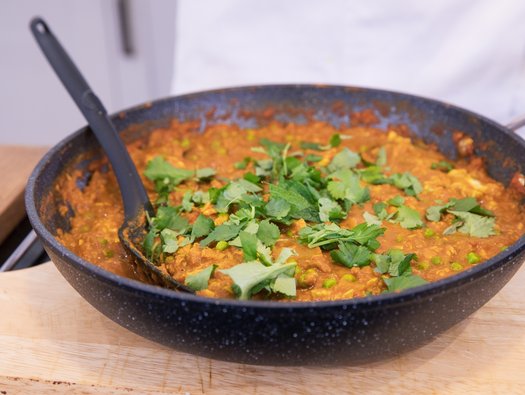Hot and sour fish curry

A delicious, punchy recipe that uses flavourful spices and herbs. It can be eaten as part of a low potassium, low phosphate and low salt diet.

A delicious, punchy recipe that uses flavourful spices and herbs. It can be eaten as part of a low potassium, low phosphate and low salt diet.
1½ tablespoons ground turmeric
1½ teaspoons ground coriander
1½ teaspoons ground cumin
½-1 teaspoon chilli powder
40g fresh ginger, peeled and finely grated
3 cloves garlic, peeled and finely grated
2-4 tablespoons cold water
1 medium white onion, diced
2 tablespoons groundnut oil (or vegetable oil)
1 tin chopped tomatoes (400g)
Juice and zest of 1 lemon
1 tablespoon dried curry leaves
1 tablespoon tamarind paste
400ml water
500g firm white fish, such as cod, hake,
tilapia or pollock, cut into bite-sized pieces
100g frozen peas
Handful fresh coriander and mint, chopped
2 green chillies, de-seeded and finely sliced
1 tablespoon vegetable oil
250g basmati rice
½ teaspoon ground turmeric
½ teaspoon dried mint
Juice and zest of 1 lemon
500ml water
1 tablespoon black mustard seeds (optional)
Curry paste: Mix the ingredients with the cold water to make a smooth paste. When adding the chilli powder, use between ½-1 teaspoons depending on your heat preference.
Curry sauce: Add the oil to a large frying pan over a medium to high heat, then add the onion. Turn the heat down to medium and fry for 10-12 minutes until soft, but not browned. Turn the heat up high, add the curry paste and cook for 1 minute, stirring constantly.
Curry sauce: Add in the tinned tomatoes, the lemon juice and zest, curry leaves, tamarind paste and water. Turn down the heat and simmer, uncovered, for 30 minutes to thicken it – make sure it is bubbling gently and stir occasionally to prevent it burning.
Lemon rice: Heat the oil in a saucepan over a medium heat, then mix in the rice, turmeric and dried mint. Stir in the lemon juice and 500ml water and bring to the boil. Cover, reduce the heat to a simmer and cook gently for about 15 minutes or until the water is absorbed.
Lemon rice: If the rice is almost cooked but a little water still remains, remove the lid for the remainder of the cooking time and turn up the heat. Meanwhile, in a dry frying pan over a medium to high heat, toast the mustard seeds (if using) for 1-2 minutes until fragrant.
Ensure the curry sauce is piping hot and then add in the fish and peas. Stir well and allow to cook for 3-5 minutes until the fish is cooked. Sprinkle the coriander, mint and chillies over the curry and the lemon zest and mustard seeds over the rice before serving.
The rice is the main source of carbohydrate in this dish and the values have been provided for those who have trained in insulin adjustment.
This dish is low in potassium, despite the use of tomatoes. This is because the quantities have been kept low. If you are following a low potassium diet, be sure to keep to the quantities and serving sizes for this recipe.
This recipe is also low in phosphate, however does contain some phosphate, provided by the fish. Therefore, if you have been prescribed a phosphate binder ensure you take them with this dish.
This dish is high in protein, mainly provided by the fish. This is an ideal dish for those receiving dialysis and requiring a high protein diet. For those advised to reduce their protein, consider using 500g of tofu to replace the fish, or a drained 400g tin of green lentils or chickpeas.
Use 500g of tofu in place of the fish.
To increase the fibre, you could use brown basmati rice instead of white – add 10 minutes to the cooking time and use 650ml water instead of 500ml.
By using whatever firm white fish is in season and local, you’ll keep costs down. You could also use frozen fish. Defrost thoroughly before cooking.
The curry paste can be made in advance and kept in the fridge for up to two days before adding the fish. You could also freeze the curry paste for up to three months.
Prawns also work well in this dish, though they are high in salt so should only be eaten occasionally. Instead of dried curry leaves, you could use eight fresh leaves.
By giving us your email address, you're giving us permission to send you the latest news from Kidney Care UK. Further information about how we protect and use your personal data is available in our Privacy policy. If you would like to change the way we communicate with you at any time please email [email protected]. You can unsubscribe at any time by using the link at the bottom of every email we send.